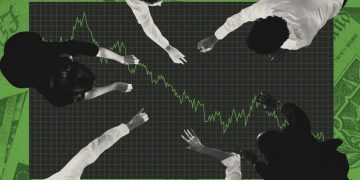As global financial conditions tighten and borrowing costs soar, emerging markets (EMs) are once again under the spotlight — not for their growth potential, but for their rising debt vulnerabilities. From Argentina to Egypt, and from Pakistan to Ghana, a wave of sovereign distress is building. Currency depreciation, rising refinancing costs, and capital outflows are straining fiscal sustainability across dozens of lower- and middle-income economies.
But this time, the question goes beyond local turmoil:
Could this mounting debt pressure in emerging markets boomerang back onto developed economies? Is the world facing a new, subtler form of financial contagion?
This article takes a deep look at the causes and structure of the emerging market debt risk, why it’s rising now, and how — directly or indirectly — the consequences could reverberate through the financial architecture of advanced economies, global markets, and policy regimes.
I. What’s Driving the Rise in EM Debt Risk?
1. Interest Rate Divergence
After years of ultra-low global rates, central banks in developed countries — especially the U.S. Federal Reserve and the European Central Bank — aggressively raised interest rates to fight inflation in 2022–2024. As a result:
- EM borrowing costs skyrocketed, especially for countries reliant on dollar- or euro-denominated debt.
- EM currencies weakened against the dollar, making debt repayment even costlier.
- Capital began fleeing EM assets, seeking higher and safer returns in U.S. treasuries and eurozone bonds.
2. Debt Accumulation During the Pandemic
Many emerging markets ramped up borrowing between 2020 and 2022 to finance:
- Healthcare and pandemic stimulus
- Food and energy subsidies
- Dollar reserves to defend local currencies
Today, they face debt-to-GDP ratios not seen since the 1980s — but without the same growth tailwinds.
3. China’s Shifting Role as a Creditor
China, once a key bilateral lender to developing countries, is now retrenching:
- Its Belt and Road lending has slowed significantly.
- Several debtor nations are in negotiation or dispute over restructuring opaque Chinese loans.
- Western creditors and multilateral institutions are being drawn into complex co-financing dilemmas.
This shift has reduced bailout options for distressed EMs, raising the systemic risk of default clusters.
II. The Fragile Frontline: Which Economies Are Under Pressure?
As of mid-2025, several EMs are flashing red or orange on sovereign risk dashboards.
High-Risk Economies:
- Argentina: Already in default negotiations for the 10th time; inflation >100%.
- Pakistan: Foreign exchange reserves below 2 months of import cover.
- Egypt: High external debt and food import dependency.
- Ghana and Kenya: In restructuring talks with IMF and bondholders.
Fragile but Not Yet Critical:
- South Africa: Weak growth and rising fiscal deficits.
- Turkey: External liabilities remain high despite recent policy tightening.
- Nigeria: Debt servicing absorbs ~80% of government revenue.
The total external debt stock of emerging markets is estimated to exceed $11 trillion, with nearly $3 trillion maturing by 2027 — much of it in hard currency.
III. Could This Impact Developed Economies?
1. Financial Spillovers Through Investor Exposure
While direct exposure to EM sovereign bonds is not systemically large for most developed-market banks, asset managers, ETFs, and pension funds hold hundreds of billions in EM debt. A cascade of defaults could:
- Trigger losses and redemptions in EM bond funds.
- Create risk-off shocks that drive global volatility.
- Tighten credit conditions worldwide as lenders reassess risk models.
Remember: it’s not just what you hold, but how correlated the losses are across portfolios. In moments of stress, diversification disappears.
2. Contagion via Currency and Trade Channels
Currency devaluations in EMs can lead to:
- Disinflationary pressures in developed economies (via cheaper imports).
- Export slowdowns for countries reliant on EM consumption (e.g., German autos, U.S. machinery, Japanese electronics).
- Greater pressure on commodity demand, affecting Canada, Australia, Norway, and other resource exporters.
In addition, financial instability in EMs can lead to destabilizing capital inflows into safe havens — distorting bond markets and complicating central bank policy in advanced economies.
3. Geopolitical and Migration Risks
Debt crises in EMs are not just economic events — they often bring:
- Social unrest, regime change, or democratic backsliding (e.g., Sri Lanka 2022).
- Outward migration from failed states, pressuring borders in Europe and the U.S.
- Geopolitical realignment, with distressed countries turning toward non-Western partners for emergency funding (e.g., Russia, China, Gulf states).
These risks can force developed nations to re-engage diplomatically and financially, whether via IMF quotas, bilateral bailouts, or security assistance.
IV. Policy Responses: How Are Institutions Reacting?
1. The IMF’s Expanded Toolkit
The International Monetary Fund has stepped in with:
- Rapid Financing Instruments (RFI) and Resilience and Sustainability Trusts (RST)
- More flexible conditionality to adapt to climate and pandemic-related shocks
But critics say IMF funding remains:
- Too slow, with bureaucratic delays
- Too small, relative to the scale of liabilities
- Too top-down, lacking debtor-country agency
2. Paris Club and G20 Common Framework
Efforts to coordinate debt restructuring across bilateral and private lenders have seen mixed success. China’s reluctance to participate in multilateral write-downs has created friction and delays.
3. Domestic Responses in Developed Economies
In the U.S. and EU:
- Financial regulators are conducting stress tests on EM exposure.
- Central banks remain alert to spillover via global funding markets.
- Foreign aid and investment programs are being redesigned to include debt transparency and fiscal resilience incentives.

V. Investment Strategy: How to Position for Rising EM Debt Risk
1. Risk Mitigation Tactics
- Reduce direct exposure to high-yield EM sovereign debt, especially those with FX mismatch.
- Prefer local-currency bonds in resilient EMs with stable policy regimes (e.g., India, Indonesia, Mexico).
- Use credit default swaps (CDS) or EM bond ETFs with liquidity screens for better risk control.
2. Look for Opportunities in Crisis
Not all EMs are created equal. Investors are selectively hunting value in:
- Distressed but reforming nations (e.g., Egypt with IMF support)
- Frontier markets with low debt and resource wealth (e.g., Kazakhstan, Ivory Coast)
- EM corporates with dollar revenues and local cost bases
3. Hedge via Developed Market Safe Havens
- U.S. Treasuries, Japanese yen, and Swiss franc may benefit from any sharp EM crisis.
- Gold, often uncorrelated with EM turmoil, is increasingly held as a cross-market risk hedge.
VI. Conclusion: No Longer an Isolated Problem
Rising debt stress in emerging markets is not just a local crisis — it’s a global warning light. Financial globalization means that shocks reverberate through:
- Investment portfolios
- Commodity prices
- Migration flows
- Institutional stability
While the risks are unevenly distributed, the potential for feedback loops into developed economies is real — especially if multiple EMs default in close succession, global growth slows, or political systems fracture.
Developed economies may think they’re insulated — but in an interconnected world, unsustainable debt anywhere becomes financial fragility everywhere.





























